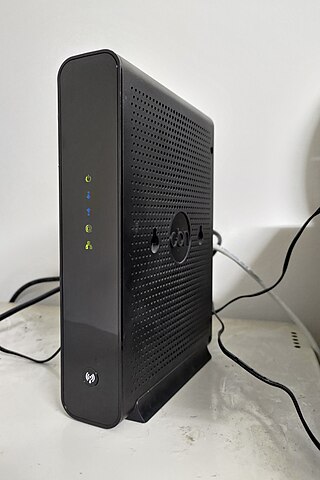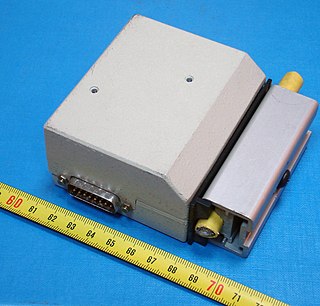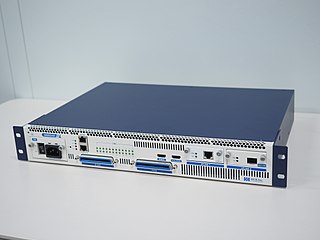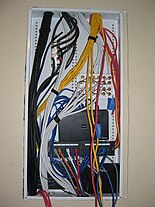The International Telecommunication Union Telecommunication Standardization Sector (ITU-T) is one of the three Sectors (branches) of the International Telecommunication Union (ITU). It is responsible for coordinating standards for telecommunications and Information Communication Technology, such as X.509 for cybersecurity, Y.3172 and Y.3173 for machine learning, and H.264/MPEG-4 AVC for video compression, between its Member States, Private Sector Members, and Academia Members.

A cable modem is a type of network bridge that provides bi-directional data communication via radio frequency channels on a hybrid fiber-coaxial (HFC), radio frequency over glass (RFoG) and coaxial cable infrastructure. Cable modems are primarily used to deliver broadband Internet access in the form of cable Internet, taking advantage of the high bandwidth of a HFC and RFoG network. They are commonly deployed in the Americas, Asia, Australia, and Europe.
Very high-speed digital subscriber line (VDSL) and very high-speed digital subscriber line 2 (VDSL2) are digital subscriber line (DSL) technologies providing data transmission faster than the earlier standards of asymmetric digital subscriber line (ADSL) G.992.1, G.992.3 (ADSL2) and G.992.5 (ADSL2+).

Power-line communication (PLC) is the carrying of data on a conductor that is also used simultaneously for AC electric power transmission or electric power distribution to consumers. The line that does so is known as a power-line carrier.
HomePlug is the family name for various power line communications specifications under the HomePlug designation, each with unique capabilities and compatibility with other HomePlug specifications.

A Medium Attachment Unit (MAU) is a transceiver which converts signals on an Ethernet cable to and from Attachment Unit Interface (AUI) signals.

HomeRF was a wireless networking specification for home devices. It was developed in 1998 by the Home Radio Frequency Working Group, a consortium of mobile wireless companies that included Proxim Wireless, Intel, Siemens AG, Motorola, Philips and more than 100 other companies.
IEEE 1901 is a standard for high-speed communication devices via electric power lines, often called broadband over power lines (BPL). The standard uses transmission frequencies below 100 MHz. This standard is usable by all classes of BPL devices, including BPL devices used for the connection to Internet access services as well as BPL devices used within buildings for local area networks, smart energy applications, transportation platforms (vehicle), and other data distribution applications.

The Multimedia over Coax Alliance (MoCA) is an international standards consortium that publishes specifications for networking over coaxial cable. The technology was originally developed to distribute IP television in homes using existing cabling, but is now used as a general-purpose Ethernet link where it is inconvenient or undesirable to replace existing coaxial cable with optical fiber or twisted pair cabling.
Design of Systems on Silicon, officially Diseño de Sistemas en Silicio S.A., (DS2), was a supplier of integrated circuits and software for power line communications. The company was founded in 1998, and went out of business in 2010 after trying to expand into other home network technologies.
Gigabit Home Networking (G.hn) is a specification for wired home networking that supports speeds up to 2 Gbit/s and operates over four types of legacy wires: telephone wiring, coaxial cables, power lines and plastic optical fiber. Some benefits of a multi-wire standard are lower equipment development costs and lower deployment costs for service providers.
Ethernet over Coax (EoC) is a family of technologies that supports the transmission of Ethernet frames over coaxial cable. The Institute of Electrical and Electronics Engineers (IEEE) maintains all official Ethernet standards in the IEEE 802 family.
Networking cable is a piece of networking hardware used to connect one network device to other network devices or to connect two or more computers to share devices such as printers or scanners. Different types of network cables, such as coaxial cable, optical fiber cable, and twisted pair cables, are used depending on the network's topology, protocol, and size. The devices can be separated by a few meters or nearly unlimited distances.

Universal charger or common charger refers to various projects to standardize the connectors of power supplies, particularly for battery-powered devices.
G.9972 is a Recommendation developed by ITU-T that specifies a coexistence mechanism for networking transceivers capable of operating over electrical power line wiring. It allows G.hn devices to coexist with other devices implementing G.9972 and operating on the same power line wiring.
Gigle Networks was a provider of high performance system-on-a-chip semiconductor devices and intelligent switching technology for home network, IPTV, consumer electronics and smart grid applications. The company was based in Barcelona, Spain, Edinburgh, UK, and Redwood City, California.
IEEE 802.11ac-2013 or 802.11ac is a wireless networking standard in the IEEE 802.11 set of protocols, providing high-throughput wireless local area networks (WLANs) on the 5 GHz band. The standard has been retroactively labelled as Wi-Fi 5 by Wi-Fi Alliance.
BroadR-Reach technology is an Ethernet physical layer standard designed for automotive connectivity applications. BroadR-Reach allows multiple in-vehicle systems to simultaneously access information over unshielded single twisted pair cable. BroadR-Reach was invented and is promoted by Broadcom Corporation, now Broadcom Limited.

G.fast is a digital subscriber line (DSL) protocol standard for local loops shorter than 500 meters, with performance targets between 100 Mbit/s and 1 Gbit/s, depending on loop length. High speeds are only achieved over very short loops. Although G.fast was initially designed for loops shorter than 250 meters, Sckipio in early 2015 demonstrated G.fast delivering speeds over 100 Mbit/s at nearly 500 meters and the EU announced a research project.
Nessum, previously HD-PLC, is a communication technology standardized by the Institute of Electrical and Electronics Engineers (IEEE). It is standardized as IEEE 1901-2020. The standard is to be used to communicate data over wired and wireless media using high frequencies between ~500kHz and ~56 MHz bands. The Nessum Alliance is the certifying body for compatibility between Nessum-based communication devices.







